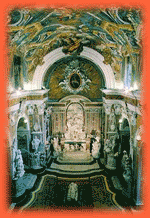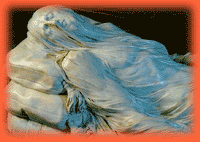|
 The
cappella Sansevero was founded in 1590, when Giovanni
Francesco Sangro wanted to pay a votive offering
by posing the first stone of a chapel in the garden
corner of his palace. The
cappella Sansevero was founded in 1590, when Giovanni
Francesco Sangro wanted to pay a votive offering
by posing the first stone of a chapel in the garden
corner of his palace.
His son Alessandro decided to enlarge the building
in 1608; these works went on until 1613.
From then on, according to the will of Alessandro
himself, the chapel was chosen as burial-place
of the family members.
During almost all the Seventeenth century, the
funerary monuments and the polychrome marbles
chosen for the decoration of the chapel were made;
unfortunately, not much of the decorative works
made in the Seventeenth century has been preserved.
The rich and variegated decorative array matches
with a simple architectonic space, made by one
rectangular nave with four big archs in every
side and a short presbytery. Within the big archs
there are the short chapels; this pattern finds
an element of exception in the third arch: there
is on the left the side entrance towards via Raimondo
de' Sangro, and on the right there is the narrow
entrance to a round underground cavea and to the
small sacristy.
The definitive shape of the chapel was found in
the following century, thanks to the uncommon
mind of the prince Raimondo di Sangro. Still today,
visiting the chapel you can feel that the decorative
array of the Pietatella has a stylish and project
unity, as the prince planned. Raimondo di Sangro
decided indeed how to arrange the statues decorations,
the theme of every allegory and painting, the
choice of the materials and of the artists who
had to make the works.
In 1749 Francesco Maria Russo was called to create
the decoration of the barrel vault; he painted
the Glory of Paradise and on the plumes the images
of Six Saints of the family; the moulding, which
was underneath the cornice, was decorated with
six medallions: here yuo can admire the scuptures
of the Cardinals of Sangro house, made by Francesco
Queirolo. Both the painted figures and those in
the medallions are fixed in expressions which
stress their virtues.
The aim to create an harmonious organism let the
prince decide to assign the decoration works to
just one sculptor; he chose the artist Antonio
Corradini, from the Veneto region who worked for
the Emperor Charles VI. He was called by the prince
of Sansevero when he was already old. Corradini
made almost all the models and fired clay sketches;
but he was able to make just few sculptures. Every
work he made is strongly characterized by the
taste of Raimondo di Sangro, who suggested him
the iconographic elements and themes. Among the
works by Corradini, let's remember the Pudicizia
(Modesty), (completely veiled, except her hands
and feet) which is on the left of the presbytery
on a basement with the Noli me Tangere by Corradini;
the Pudicizia was commissioned by Raimondo to
honour the memory of his mother Cecilia Gaetani
dell'Aquila d'Aragona, who died young. After the
death of Corradini (1752) the sculptor Francesco
Queirolo from Genua came to Naples.
 He
was younger than Corradini and studied mostly
in the Roman sphere; he was given the direction
of the works in the Cappella Sansevero and basically
he followed the project scheme of his predecessor. He
was younger than Corradini and studied mostly
in the Roman sphere; he was given the direction
of the works in the Cappella Sansevero and basically
he followed the project scheme of his predecessor.
Queirolo made the sculptures of Santa Rosalia
and of Sant'Odorisio, placed one in front of the
other respectively on the right and on the left
of the last chapels.
Queirolo masterpiece is the virtuosic Disinganno
(Disillusionment), work of art dedicated to Antonio
de' Sangro, who was Raimondo's father. The Disinganno
is on a basement with the figure of Christ who
gives the sight to a blind man; in this sculpture
Queirolo creates a refined and unbelievable fretwork
of the net; the net represents the process of
freedom of mankind, thanks to the intervention
of a genie, who symbolizes the will of rebirth.
This sculpure is placed in front of the Pudicizia
by Corradini.
Because of a progressive bad relationship between
the prince and Queirolo, after 1759 the decoration
works of the chapel were given to neapolitan artists.
Francesco Celebrano made the relief of the high
altar with the Deposition and the monument to
Cecco de' Sangro (1766), placed on the main entrance.
Cecco de' Sangro is here represented in the act
of going out his grave with a sword in hand. The
two angels that are on the sides of the high altar
were made by Paolo Persico, as the Soavità
del giogo maritale (Sweetness of the marital yoke)
too. The only two paintings of the chapel were
made by Carlo Amalfi; they are the Portrait of
Raimondo di Sangro (1759) and the Portrait of
Vincenzo de' Sangro (1771), son of the prince.
The still young Giuseppe Sanmartino made the sculpture
of the so called Cristo velato (Veiled Christ),
(1753) that represents his only signed work. This
sculpture, considered the most beautiful sculture
of the neapolitan Settecento, was inspired by
a Corradini fired clay model; even if Sanmartino
did not change the composition,he created new
effects of light and shade, giving the Christ
an uncommon expressive strenght.
Among the large number of fans of this work, there
was also the sculptor Antonio Canova.
Before ending the description of the cappella
Sansevero, it is worth reminding that in the underground
cavea two anatomical structures (representing
a man and a woman) are preserved. They show the
circulatory system and the inner organs on real
skeletons; as they appear so real, they contribute
to increase the mystery that until today has been
wrapping the figure of the prince .
|




 The
cappella Sansevero was founded in 1590, when Giovanni
Francesco Sangro wanted to pay a votive offering
by posing the first stone of a chapel in the garden
corner of his palace.
The
cappella Sansevero was founded in 1590, when Giovanni
Francesco Sangro wanted to pay a votive offering
by posing the first stone of a chapel in the garden
corner of his palace.  He
was younger than Corradini and studied mostly
in the Roman sphere; he was given the direction
of the works in the Cappella Sansevero and basically
he followed the project scheme of his predecessor.
He
was younger than Corradini and studied mostly
in the Roman sphere; he was given the direction
of the works in the Cappella Sansevero and basically
he followed the project scheme of his predecessor.